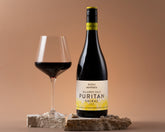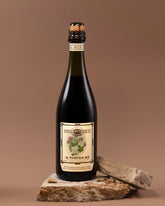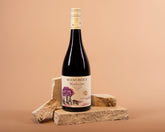When it comes to enjoying red wine, there’s a lot more to it than simply opening the bottle and pouring it into a glass. Proper storage, the right serving temperature, and even decanting play huge roles in ensuring that the wine reaches its full potential and offers the best possible experience. At Guilt Free Wine, we believe that storing and serving red wine is more than just a ritual; it’s a commitment to preserving the essence of every bottle.
Table of Contents
- Key Takeaways
- How to Properly Store & Serve Red Wine
- The Importance of Decanting Red Wine
- Conclusion
- FAQs:
Key Takeaways
- Store red wine in a dark, cool place with stable humidity.
- Ideal serving temps: 12°C–14°C (light reds), 15°C–18°C (bold reds).
- Decanting enhances aroma and smooths tannins.
- Avoid room temperature assumptions, especially in hot climates.
- Use proper glassware and pour slowly to maximise enjoyment.
How to Properly Store & Serve Red Wine
There’s something about a glass of red wine that invites depth, warmth, and time. But behind that beautiful pour is a story that begins long before the bottle is opened. How we store and serve varieties of red wine directly impacts their taste, texture, and aroma. Whether you’re holding onto a cherished vintage or opening a bottle tonight, the details matter. Beyond flavour, ingredient of red wine have been linked to notable health-supporting properties, making every sip more meaningful.
Storing Red Wine: Creating the Right Environment
The first step in ensuring that our wine is ready to drink at its best is proper storage. Wine is a delicate beverage, and how we store it has a direct impact on its quality. Here are a few simple rules to follow:
- Store Wine Horizontally: If we’re storing wine for any length of time, it’s important to keep the bottles lying down. This is essential, as a dry cork can shrink, letting air into the bottle and potentially spoiling the wine. We want to preserve that tight seal to maintain the wine’s integrity.
- Temperature is Key: Ideally, we should store our wine in a cool, dark place. Red wine should be kept at a temperature between 50°F and 60°F (10°C and 15°C). This temperature range helps maintain the wine’s aging process without causing it to age too quickly or degrade prematurely. If we don’t have a wine cellar or a designated wine fridge, we can store our wine in a basement or even a cupboard that stays cool and away from heat sources.To maintain ideal conditions, it’s important to choose best wine fridge that allows precise temperature control and consistent storage.
- Avoid Fluctuating Temperatures: Consistent temperature is vital for long-term storage. If we allow the temperature to fluctuate too much, the wine can expand and contract, which can lead to oxidation and spoilage. Try to avoid areas that are prone to temperature swings, such as above the kitchen refrigerator or near windows where sunlight and heat can affect the wine.
- Humidity Matters: Humidity is another important factor when storing wine. The ideal relative humidity for wine storage is around 60% to 70%. If the air is too dry, the cork can dry out, and the wine will suffer. On the other hand, excessive humidity can lead to mold or mildew growth. If we don’t have a climate-controlled wine fridge, a damp cloth in a wine cabinet can help maintain the right moisture levels.
- Keep it Away from Light and Vibrations: Wine, especially red, is sensitive to light and vibrations. Sun exposure and ultraviolet (UV) radiation can damage the wine and cause it to age prematurely. For this reason, it’s important to store wine in a dark environment, away from direct sunlight. Likewise, constant vibrations can disturb the delicate balance of the wine, so it’s best to avoid placing wine near loud appliances or high-traffic areas.
The Ideal Serving Temperature for Red Wine
Once we’ve stored our wine properly, the next step is to serve it at the right temperature. Serving red wine at the right temperature can enhance its flavors and aromas, while serving it too warm or too cold can mask its true potential.
- Light-bodied Red Wines: Some wines like Pinot Noir and Gamay, which are lighter in body, should be served slightly cooler, around 55°F to 60°F (13°C to 16°C). Chilling these wines just a bit helps bring out their delicate fruit flavors and keeps them refreshing.
- Medium-bodied Red Wines: Reds such as Merlot, Sangiovese, and Zinfandel should be served around 60°F to 65°F (16°C to 18°C). This temperature range allows the fruitiness and complexity of the wine to shine without being overshadowed by the alcohol.
- Full-bodied Red Wines: Heavier reds like Cabernet Sauvignon, Syrah, and Malbec are best served at 65°F to 68°F (18°C to 20°C). Serving these wines slightly warmer helps to bring out their bold flavors, tannins, and complexity. If the wine is served too cold, the flavors might seem muted, and the tannins might feel overly harsh.
To reach the optimal temperature, we can chill wines that are too warm in the refrigerator for about 15 to 30 minutes before serving. Conversely, if the wine is too cold, letting it sit at room temperature for a while can help bring it to the right level.
The Importance of Decanting Red Wine
Now, let’s talk about decanting, an often-overlooked step in preparing a collection of red wine bottle. Decanting is the process of transferring wine from the bottle into a decanter to aerate it, allowing it to breathe and release its full bouquet of aromas and flavors.
- Why Decanting Matters: The main reason we decant red wine is to allow it to interact with oxygen. When we pour the wine into a decanter, it gets exposed to air, which can help soften the tannins and improve the overall texture. This is especially beneficial for young, tannic wines that need some time to open up. Decanting also allows any sediment that may have formed in the bottle to settle, ensuring that the wine is smooth and clean when poured.
- When to Decant: Not every red wine needs to be decanted. Lighter wines, like Pinot Noir, usually don’t require it and are best served straight from the bottle. However, wines that are more robust, such as Cabernet Sauvignon, Bordeaux, and Syrah, benefit greatly from decanting. For young wines, we may want to decant for an hour or so, while older wines may need less time, perhaps 30 minutes, to allow their aromas to develop without becoming too exposed to oxygen.
- How to Decant: To decant, we simply pour the wine gently into a decanter, leaving any sediment behind in the bottle. For maximum benefit, we should let the wine sit in the decanter for the appropriate amount of time based on its age and type. Using a glass decanter with a wide base will allow more surface area for the wine to interact with air.
Conclusion
Storing and serving red wine correctly isn’t a luxury, it’s a form of respect for the craft and care that went into the bottle. At Guilt Free Wine, we’re passionate about helping you enjoy wine the way it was meant to be experienced, rich in flavour, true to its character, and free of compromise. Have questions about wine selection, serving, or storage? Contact Guilt Free Wine, we’re here to help you elevate every pour.
FAQs:
What temperature should red wine be stored at?
Red wine should be stored at 12°C–18°C in a cool, stable environment away from sunlight.
Can red wine be refrigerated?
Yes, briefly. For over-warm bottles, 15–20 minutes in the fridge can bring the temperature into the ideal range.
How long should I decant red wine?
Young reds benefit from 30 minutes to an hour. Older reds may only need 15–30 minutes to avoid overexposure.
Why does wine taste different at different temperatures?
Temperature affects aroma, flavour intensity, and alcohol perception. Cooler temps mute flavour, while warm temps can exaggerate alcohol.
Is it necessary to store wine bottles on their side?
Yes, especially for cork-sealed bottles. It keeps the cork moist and prevents air from entering.
Does all red wine need to be decanted?
Not all, Young, bold reds often benefit the most. Lighter reds or wines with minimal tannins may not require decanting.







